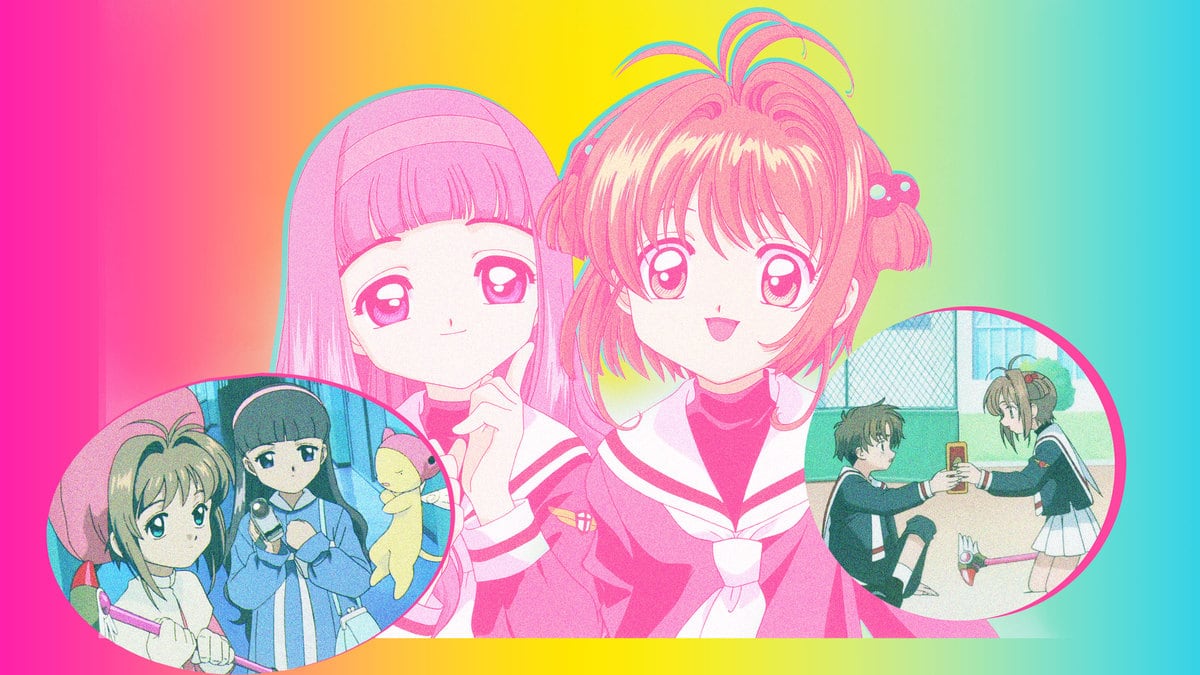The Cardcaptor Sakura anime premiered more than 25 years ago this month, and my insides are turning to dust just thinking about it. Based on the beloved manga by artist collective CLAMP and animated by the well-known studio Madhouse (Death Note, Monster), the TV adaptation debuted in Japan on April 7, 1998. It would go on to be dubbed into English, then renamed Cardcaptors in the West.
Cardcaptors became integral to my after-school routine in the early 2000s. Racing home, I’d dump myself in front of the TV to watch each new episode. Then, once finished, I’d rewind the VHS on which I’d harangued my mother to tape every episode and watch it again (this time to catch the 10 minutes I’d missed while walking home). That tape is long gone, but a quarter-century after its release, Cardcaptor Sakura remains beloved—by me and by other fans; not so much by my mother—for its enduring portrayal of youth and, more pointedly, its revelatory queerness unlike anything on TV at the time, all wrapped in a kid-friendly monster of the week package.
The series follows Sakura, a fourth-grader who lives with her widowed father and teenage brother, Tōya. One evening after school, Sakura accidentally releases the seal on a book containing the magical Clow Cards, which house fantastical spirits that suddenly disperse across the city. With the help of the book’s pudding-loving guardian, Keroberos, and her best “friend” Tomoyo (more on that later), Sakura sets out to catch and return the Clow Cards to the book, in an arc spanning 70 episodes and two feature films.
Only 70 episodes and two short movies isn’t a long run by 1990s mainstream anime standards. Yet Cardcaptor Sakura grew with its pre-teen audience in small, relatable increments. In the face of the perpetual agelessness of Ash Ketchum, Cardcaptor Sakura offered a sense of momentum across its series-long narrative. Most meaningfully, its story offered a more grown-up alternative to anime available to Western kids at the time.
Though it tapped into pointedly ’90s trends, including copious rollerblades—which 10-year-old me thought were wicked-cool, though never cool enough to actually try—Cardcaptor Sakura never felt cynical. Its earnest tone was helped by Sakura not fulfilling the usual “Magical Girl” role, commonly held by characters like Sailor Moon. She doesn’t fight evil. Rather, she eases restless spirits in a way that mirrors her own feelings of being a preteen: that of being suddenly too young and too old.
“I didn’t want Sakura to be a Super Elementary-School Girl,” Nanase Ohkawa, a member of CLAMP, said in an interview published in CLAMP No Kiseki in 2004. “She can’t do everything; she struggles with math, and she does well with physical exercises. Everything she cooks is fairly simple, like okonomiyaki and pancakes, which might be the most a normal fourth-grader is capable of.”
This sense of authentic storytelling is aided by Madhouse’s track record of realistically proportioned artwork, which positioned Cardcaptor Sakura at odds with other contemporary anime. Removed from the hyper aesthetic of similar-genre shows like Sailor Moon, the anime became remarkably familiar to modern viewers. Sakura may have battled magical beings at night, but during the day, life revolved around homework, baking cakes, doing chores, hanging out with friends, and navigating first loves.
Those relationships form the core of Cardcaptor Sakura’s lasting appeal, whether it’s Sakura’s obsession with Yukito, her brother’s best friend and later boyfriend, or how sensitively the show handles Tomoyo’s unrequited romantic interest in Sakura. The show’s realistic grounding helps drive home its lessons on the openness of love in all its forms—lessons that stay with you even two decades after first seeing them.

LGBTQ+ themes were by no means unusual in anime at the time, but Cardcaptor Sakura infused its whole being with the idea that love is love. Importantly, it did so while also making the transition to a less permissive Western media.
In a Comic Book Resources piece from 2020, Anthony Gramuglia asserts how pivotal a non-heteronormative approach to love was to the show’s central message. “That love exists regardless of all other factors,” he writes. “The series teaches its target audience of young girls that love knows no bounds.”
Through its narratives of fluid sexuality, exploration of gender, and the employ of transgender, bisexual, and agender characters, Cardcaptor Sakura was likely the first introduction many of us young viewers had to non-stereotypical, sympathetic LGBTQ+ characters. For me, the show’s open queerness feels especially important in retrospect; I grew up in a bigoted household, and embracing Cardcaptor Sakura was my first step toward shedding everything I ever subconsciously learned from my family.
In an interview in the 2001 Card Captor Sakura Memorial Book, Ohkawa spoke of the series’ diverse, accepting approach to sexuality. “I wanted a story with a protagonist who had an open mind towards different family structures, different kinds of love, and different perspectives from society,” she said.
That’s not exactly emblematic of ’90s Western TV—which is probably why that open-minded version of Sakura was only seen in Japan. When adapting the show for Western audiences, networks tried to water down its portrayal of the complexity of love. Episodes were edited, reordered, and some weren’t even shown outside of Japan—all to remove allusions to LGBTQ+ themes and align it with other sanitized imports, like Pokémon and Digimon.
The networks couldn’t get all of those references out, though. So ingrained were themes of queer love that they managed to break through the multiple layers of censorship in the English-language dub, to maintain the Western Cardcaptors as one of the queerest shows on TV at the time. After all, you can change the script, but the animation remains the same.
Tōya giving Yukito his magic remains a remarkably tender moment between two male-coded characters in the dub, even in 2023. Syaoran—Sakura’s classmate and crush—may not have been openly attracted to Yukito as he is in the Japanese original, but he still blushed every time Yukito was near him. And as much as the dub tried to paint Tomoyo and Sakura as Very Good Friends™, it was clear, even in English, that Tomoyo harbored strong romantic feelings for Sakura.
“I still picked up on the queerness,” writes Shamus Kelly in Den of Geek, reflecting upon the series in 2020. “Not directly, mind you. I was 9 years old and still hadn’t had my first crush yet. [But] because of Tōya and Yukito, I was able to figure out my sexuality in a safe way. I wasn’t afraid of the slow realization that I liked women and men; I knew it was okay because Cardcaptor Sakura showed it was okay.”

Cardcaptor Sakura was just that: a welcoming, safe place. And while Sakura and Syaoran ultimately ending up together might seem to undermine the impact of the show’s queerness, Ohkawa was keen on fans not seeing it that way.
“I am glad that the readers are happy that Sakura and Syaoran got together, but that anyone would think it’s because they make [an obvious] couple… it’s a little disconcerting,” she said in the Card Captor Sakura Memorial Book. “Sakura didn’t choose Syaoran because he’s a boy close to her in age. If Syaoran had been a girl, if they had been far apart in age, as long as he was still Syaoran, I think Sakura would have fallen in love with him. It’d sadden me if you thought they’re a good couple because they’re [heterosexual].”
This claim isn’t made in performative hindsight, like, say, making Dumbledore gay years after the fact with no textual reference. That Sakura could have ended up with Syaoran regardless of who he was, and that any character could do much the same in their own relationships, was fundamental to the show and to Sakura’s character—something even censorship couldn’t mask.
Still, Cardcaptor Sakura remained a risk, even in the more permissive landscape of ’90s Japanese anime.
“I wondered how the series would be received, since it ran in Nakayoshi [a long-running manga magazine aimed at young girls], but it was received better than I expected,” Ohkawa said in 2001, before later adding, “There may be people who think that elementary school children are incapable of that much maturity, but there are many children who are that wise, and suffer for it.”
For all its popularity, Cardcaptor Sakura wasn’t a seminal show in the grand scheme of the medium; it didn’t reignite interest in the waning Magical Girl genre, nor did it shake up anime. But it was different. It never assumed incompetence on the part of its young audience. It never claimed that we weren’t ready for its lessons. It told us things were changing, and that’s okay—it’s all okay. Everything will be okay.
Now, with the 25-year-old show streaming on Netflix (in the US, at least) with a more faithful (and gayer) dub, Cardcaptor Sakura can give a newer generation the sense that yes, everything will be okay.






